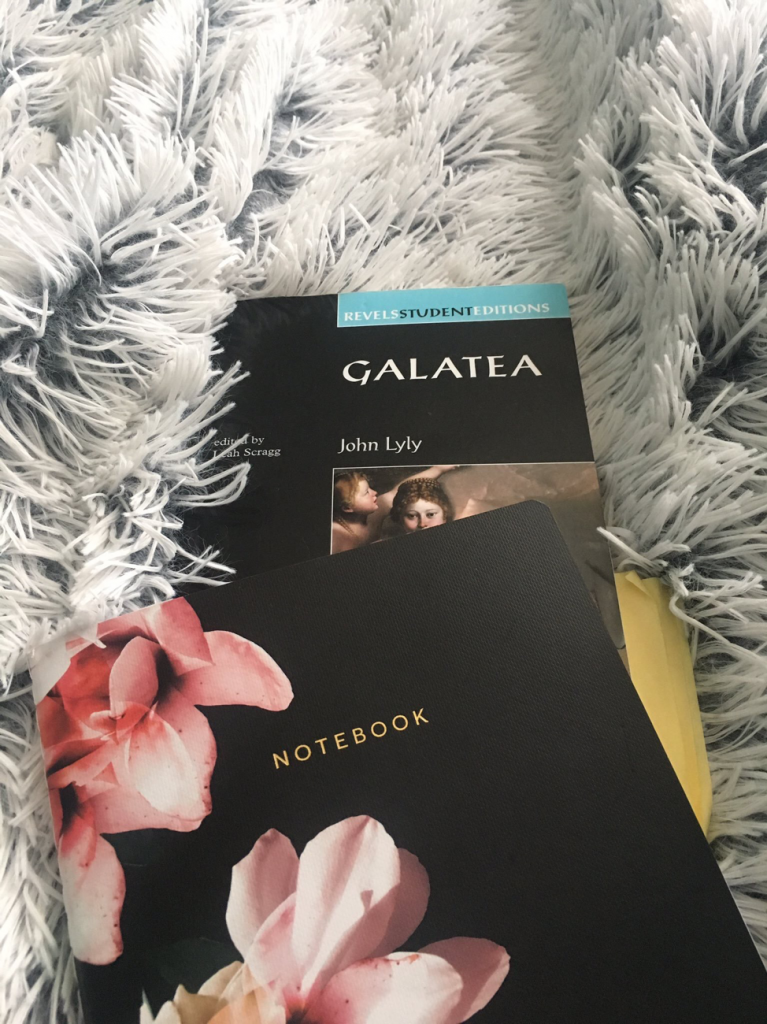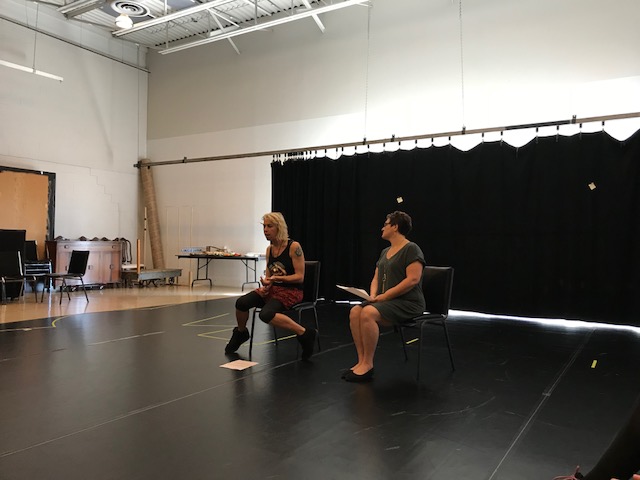By Madeleine Krusto
Oyez, oyez, if any maid
Whom leering Cupid has betrayed
To frowns of spite, to eyes of scorn,
And would in madness now see torn
The boy in pieces…
John Lyly, Galathea, 4.2.1-4
We are dressed as Diana’s nymphs standing in a circle surrounding Cupid, who sits crouched on the floor in front of us. One nymph rips Cupid’s bow and arrow from their hands. Another unclips Cupid’s wings. We move closer. Diana places a bright red copy of the Royal Shakespeare Company’s Complete Works of William Shakespeare on Cupid’s back. The pages are open towards us, barely touched, and in pristine condition.
For a moment I stop. I don’t know what I’m supposed to do next. This was definitely not in my Galathea text. I know how the scene is supposed to play out: the nymphs are instructed by Diana to punish Cupid for influencing them in acting out. But I don’t know how we are supposed to actually go about performing this with a heavy copy of Shakespeare’s work in the middle of us.
One of the nymphs reaches down and rips a page from the RSC collection. Then another. What follows next is a visceral scene: each performer takes a turn tearing a page from the book. We all forget about that initial hesitation. I look down at my hands and there are crumpled pages between them. I don’t even look at what play I just ripped the text from, because it doesn’t matter. I throw pages on the ground, I step on them, I tear more from the book and begin ripping the individual pages into pieces. I want the pages to be unrecognizable. With our nails, we are ripping Shakespeare’s work out of the centre of the archive.
This moment, which took place at the Stratford Festival’s 2019 Theatre Laboratory, was part of the weeklong workshop “Towards a Trans Canon” led by visiting artist Emma Frankland. I first met Emma in September of 2018 when she was one of the invited artists for the “Engendering the Stage in the Age of Shakespeare and Beyond” conference at the Stratford Festival and McMaster University. Invited by Emma to come back to the Lab to attend this day of her “Towards a Trans Canon” workshop, I had the opportunity to participate in a Performance as Research exploration of the trans performance canon and its relationship to the early modern canon (with Shakespeare at the centre).
As Emma noted throughout the day, there is no complete works of a trans canon archived in a single book, the way there is for the Shakespeare canon. We were being given permission to rip pages from the complete works of Shakespeare both to decentre his name and to make space for the trans canon. The PaR work led by Emma at the Stratford Festival Theatre Lab offered a site for contributing to such a canon through finding queer life within texts such as Galathea, written by Shakespeare’s immediate predecessor, John Lyly. Although an archived canon of trans work does not exist so neatly as Shakespeare’s collection, then, Emma’s workshop suggests that an ongoing repertoire of trans performance (both in early modern and contemporary performance) is what makes up the trans canon.
Accompanying Emma was a group of trans, 2 spirit, and non-binary identifying artists from Canada, the United States, and the United Kingdom. I soon understood how important it was for Emma to have brought the invited artists with her into the space. Rather than relying on Emma as the only voice in the room speaking about trans lives as though her story represented every trans narrative, the workshop featured multiple voices speaking to their own lives, their own stories, and their own narratives. It did not become the job of one single trans person to speak on behalf of all trans lives as a universal narrative for the cisgender folk present in the room.
For most of the day we worked through selected scenes from Lyly’s Galathea. In the morning, all participants explored the text together through music, dance, and non-verbal scenework, under Emma’s direction. After lunch, the artists split into groups and worked through specific scenes, text in hand.

I was given the opportunity to observe one of the small groups workshopping – and I was drawn again, as I had been when Emma presented this scene last year with “Engendering the Stage,” to one of the scenes near the beginning of the play, where Philida’s father tells her she must hide in the woods dressed as a boy.
It was an extremely exciting experience to watch two artists work with this scene from Galathea imagining the character of Philida as gender-fluid. At the same time, though, I felt that I suddenly changed from a participant in the PaR work to a spectator at a performance. Although I was still participating in the PaR scholarship, the space of the scenework had shifted toward becoming more of a performance space.
As a cisgender woman invited into this space, a workshop series on the trans canon, it felt important to take up as little space as possible while also not sitting on the sidelines and simply watching the PaR work as if I was situating myself as an expert on transgender lives. When I was a performing participant, such as performing a nymph and ripping the pages from that RSC collection, I was still taking up space in some ways, but also sharing the space with the artists in the room. Together we were unified and working toward something. Being in such an intimate space, it completely changes the dynamic when I am invited to participate, but choose not to. If I am situated on the outside, it feels as though everyone else is performing for my own benefit. When others sit and watch the exploration process that comes with PaR, scenework and discussions between participants become performative for the others watching, whether it be other artists, scholars, or members of the public.
The most rewarding aspects of the 2019 “Towards a Trans Canon” workshop, for me, were the moments of active engagement — where everyone was free to explore, discover and create. We warmed up together, we dressed in costume together, we ripped the pages of Shakespeare together. I am an emerging artist, and a young student just beginning her MA degree and grappling with imposter syndrome. I am still learning where I belong, whether it is in the community practicing my art, in academia, or both. For this day at Emma’s workshop, I did not feel any of these insecurities. Yes, it was incredibly intimidating to be a participant alongside professional artists, but as soon as this initial fear faded away, I was just another participant in the space. It did not matter that I was a young student, a new artist, someone still learning. I was there simply to explore and create with peers.
So there we were together, as participants, ripping the pages of Shakespeare’s complete works. Even though this was a performance, it was a performance for ourselves, for the purpose of exploration; and this was so vitally important to the work and why PaR was being done. Despite the performative element that PaR suggests in its name, this research is intimate work that requires participatory roles from each person in the space. It is an active space. To sit on the sidelines and watch PaR in action is to take more than you are giving to the work.
This research is a constant cycle of placing yourself into the participation, exploration, and discovery. Perhaps the first step to breaking down barriers between participants is acknowledging that this learning happens together. You are allowed to rip the pages too.

